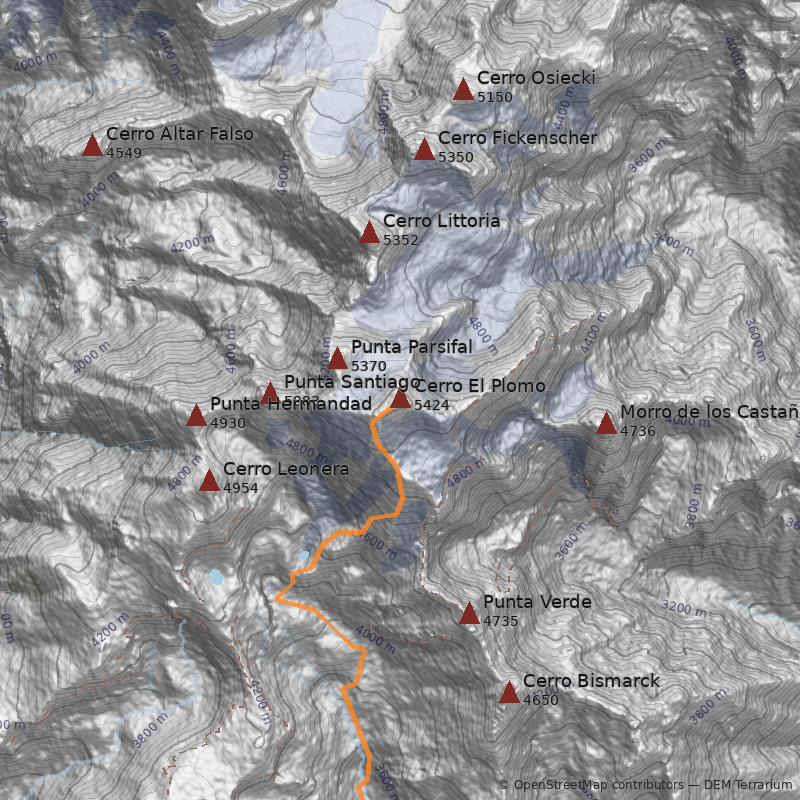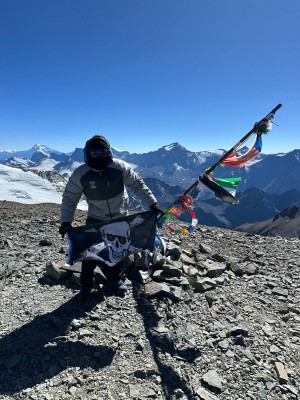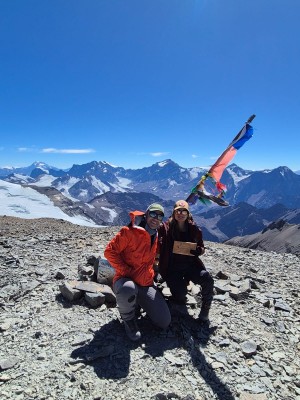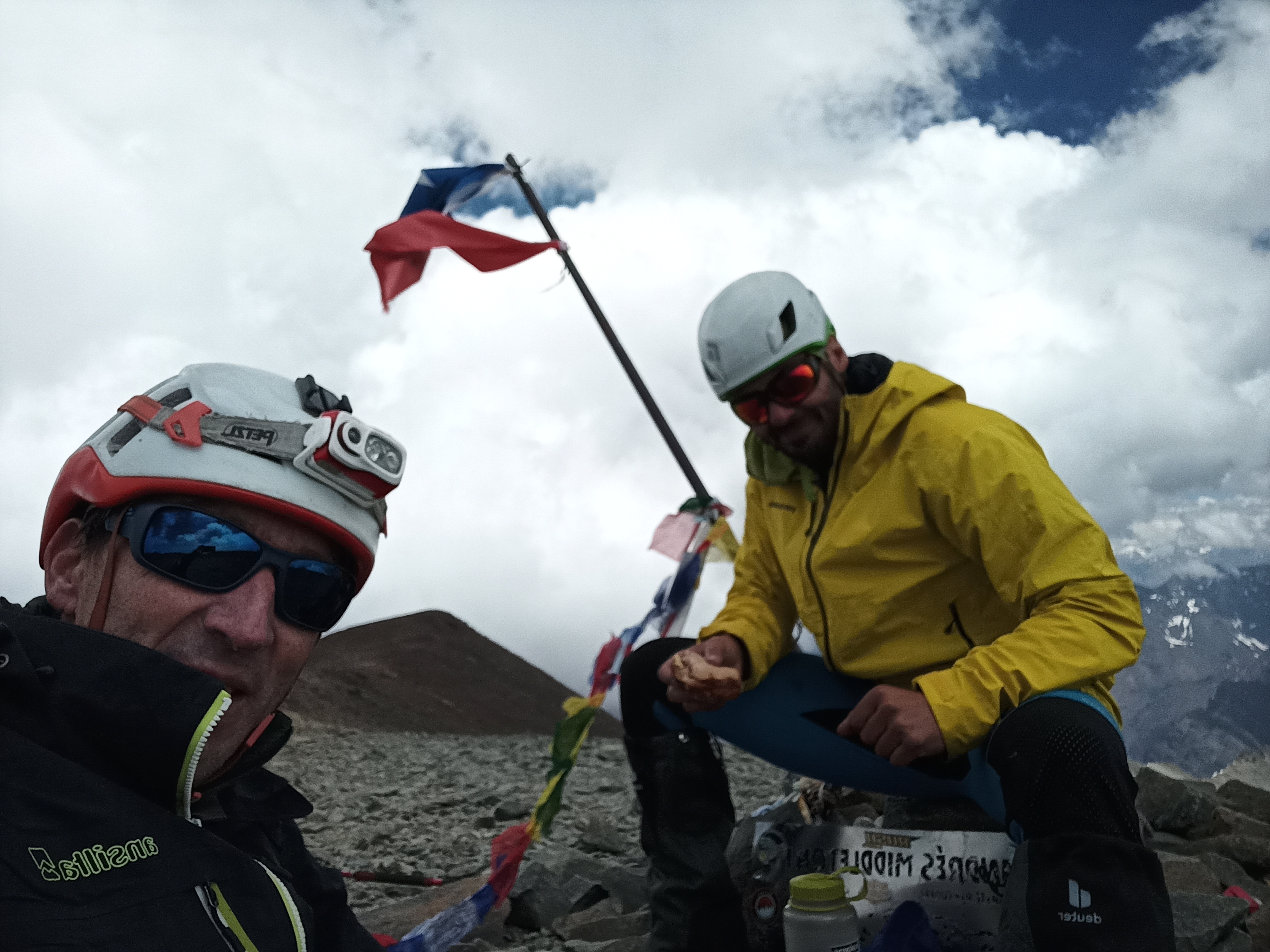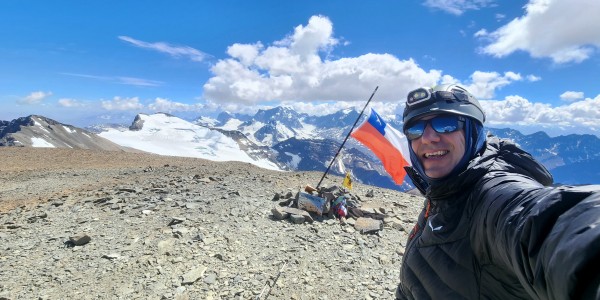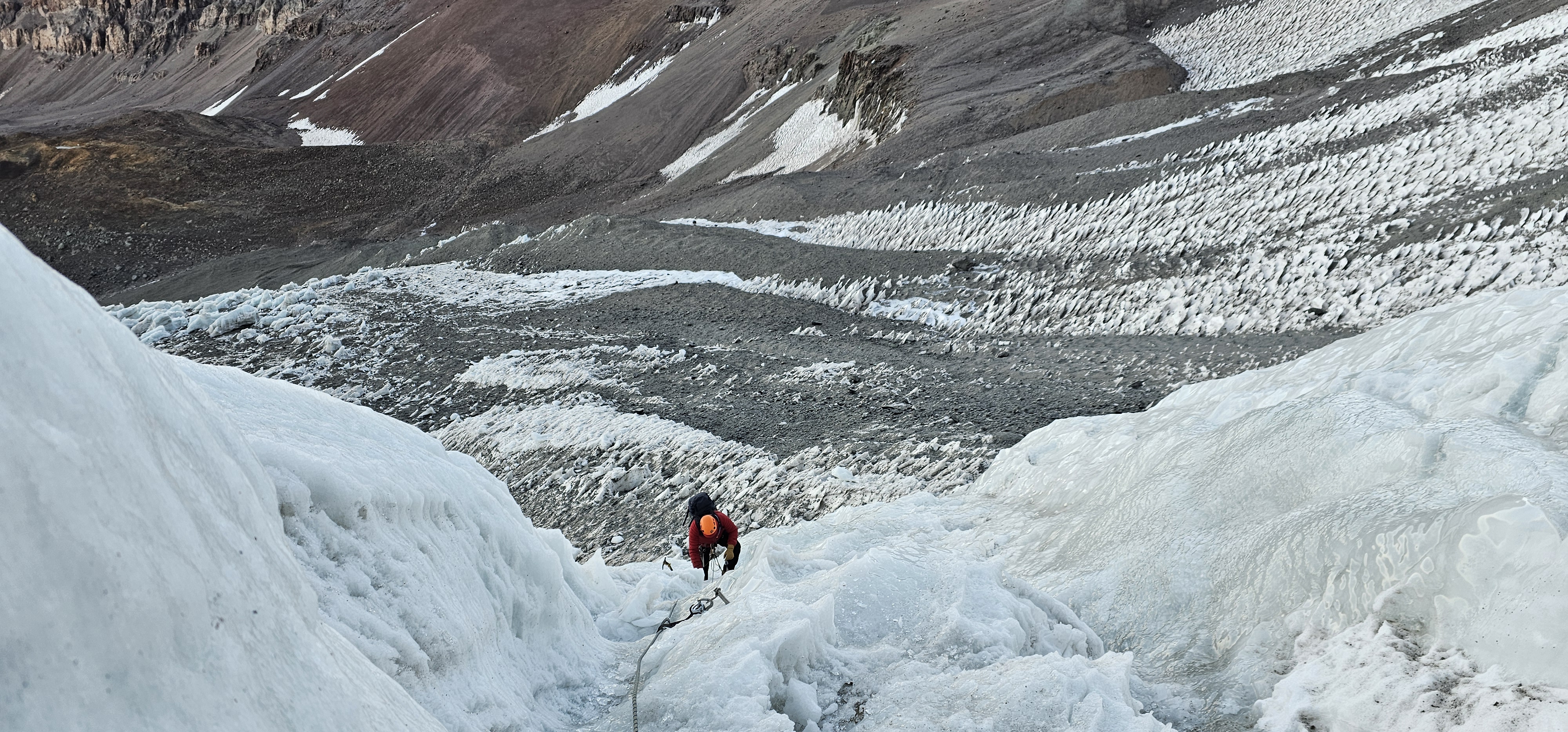Características de la montaña
Primera ascensión
- Gustav Brant (CL)
- Rodolfo Luck (CL)
Rutas publicadas
Presentación
El Plomo es un cerrazo. Escogido por los incas como "Apu" (guardián), domina todo el valle central del Mapocho, abasteciéndolo generosamente de agua proveniente de sus diversos glaciares. Desde su cara sur nace el estero Cepo, que a poco andar cambia de nombre (río Molina), y que junto al estero de Yerba Loca, forman el río Mapocho. Desde los glaciares más orientales y septentrionales, en cambio, el Plomo alimenta al río Maipo. Primero alimentando el río Olivares, afluente principal del río Colorado, que antes de dejar los valles cordilleranos interiores se suma al caudaloso Maipo.
El Plomo es visible desde prácticamente todo el valle central del Maipo, desde Graneros hasta Lampa. También lo es desde todas las altas cumbres de la zona, incluyendo aquellas de la cordillera de la Costa. Por esta razón, y por su imponente figura maciza, el Plomo fue escogido como santuario por los incas. En su espinazo cumbrero se celebró la ceremonia sagrada más importante en la cultura incaica: el capac cocha. Evidencia de este evento es el hallazgo de un niño congelado (cauri pacsa) en una pirca tapada con piedra y tierra sobre su filo somital. Su descubrimiento ocurrió hacia las tres de la tarde del 1 de febrero de 1954, cuando los arrieros Luis Ríos Barrueto, Guillermo Chacón Carrasco y Jaime Ríos Abarca removieron material desde la pirca principal. En la actualidad, el niño se encuentra en el Museo Nacional de Historia Natural en Santiago, aunque no para su exposición a público, debido a que el Museo adscribe a la convención de UNESCO de no exhibir restos humanos en museos, por respeto a los pueblos originarios.
El poco emotivo nombre de Plomo, al parecer, le fue dado al cerro por pirquineros de la zona que usaban este término para referirse a un cerro en el que no encontraban nada valioso, ni oro ni plata. Por esta razón es que el nombre se repite con frecuencia en los Andes centrales de Chile. Por su parte, la denominación "Apu Wamani" que alguna popularidad ha ganado en el último tiempo, corresponde a un nombre moderno en lengua quechua que algunos han intentado dar al cerro y no corresponde a la denominación original que los habitantes nativos pudieron darle. Lamentablemente el nombre original dado por la habitantes nativos al cerro se ha perdido puesto que no quedó registrado en ningún documento.
El niño de El Plomo y la historia de su hallazgo
Lunes 1 de febrero de 1954, cerca de mediodía. A más de 5000m de altura, sobre el extremo meridional del largo espinazo cumbrero del macizo El Plomo, se produce un descubrimiento singular, trascendente de significado histórico y cultural. Los protagonistas: una partida de arrieros buscadores de tesoros indígenas (wacas), conformada por los puentealtinos Luis y Jaime Ríos, tío y sobrino, y el ideólogo y líder Guillermo Chacón, alias “El Abuelo”, un avezado baquiano que no pudiendo ir a la cumbre por su edad, dirigiría todo desde el campamento alto.
Tal como lo habían planeado, y siguiendo las instrucciones del “Abuelo”, los Ríos, con pala y chuzo, removieron material y piedras de la más grande de tres estructuras rectangulares de pircas de piedras que hay cerca de la cumbre del cerro. Con gran asombro descubrieron que la pirca cobijaba en su interior a un niño congelado, que junto a un rico ajuar y obsequios fúnebres, había dormido allí acurrucado por cerca de quinientos años, tutelado por las nieves eternas del cerro de cabecera del valle del Mapocho. El descubrimiento había proyectado luz sobre un ascenso pretérito no registrado con carácter de sagrado.
Los arrieros bajaron el niño a Santiago. Tras prolongadas y difíciles negociaciones deciden entregarlo al Museo de Historia Natural de Santiago (MNHN), lugar donde se encuentra actualmente bajo estricto cuidado y no para la exhibición para el público. La primera investigación exhaustiva del niño fue dirigida por la arqueóloga de origen austríaco Grete Mostny, quien fue luego directora del MNHN. Su investigación arrojó resultados interesantes como la edad estimada del niño al morir, que éste padeció mal de altura antes de morir y, en base a su ornato, su procedencia incaica, entre varios otros descubrimientos.
Miembro de una distinguida familia incaica proveniente de una región del norte de Chile o Bolivia, el “niño de El Plomo” habría tenido aproximadamente ocho a nueve años de edad al momento de morir. Tras una prolija selección, habría sido escogido como ofrenda para su sacrificio en la ceremonia oficial de Estado más importante y sagrada en la cultura inca, el capac cocha, efectuada en el valle del estero Cepo y la cumbre misma de El Plomo. Este rito se realizaba para apaciguar a los dioses (el “Inti”, sol, o posiblemente también las montañas mismas) en ocasiones especiales en las que el Inca o el Estado se veían amenazados.
Este sorprendente hallazgo no debe ser subestimado. Es uno de los testimonios más palpables y significativos de la intensa actividad incaica en el valle del Mapocho antes de la llegada de los conquistadores europeos. Más aún, lo es de las costumbres, cultura y ritos sagrados de los incas; y del carácter sagrado de El Plomo y su ascenso durante el imperio incaico. El Plomo es uno de los santuarios de altura más importantes que se ha descubierto y el valle del Cepo un museo abierto de vestigios precolombinos a descubrir y respetar.
¿Qué llevaba y tenía el niño junto a él en la pirca donde fue encontrado?
Aparte de una bolsa de cuero con restos de coca que lleva puesta en forma de bandolera, se encontró junto a él otra bolsa, recamada con plumas rojas y blancas, conteniendo hojas de coca, un conjunto de cinco bolsitas de cuero, que tenían pelo, dientes de leche, recortes de sus uñas y dos figuritas de auquénidos, una de una aleación de oro y plata y la otra de un trozo de concha exótica. Sepultada aparte, pero en el mismo lugar, se encontró una figurita de plata representando una mujer vestida de tejidos brillantes y tocado de plumas rojas (Mostny (1957)).
¿Cuánto pagó el Museo Nacional de Historia Natural (MNHN) a Guillermo Chacón y Luis Ríos por el “conjunto” (el niño más todo su ajuar y atuendos)?
Según el relato de Luis Ríos el director del MNHN en aquel entonces, Humberto Fuenzalida, les habría ofrecido $4.500 de la época, arguyendo lo “miserable del presupuesto del museo”. Luego la doctora Greta les ofreció $85.000 por el “conjunto”, que debían recuperar luego de dejarlo en Piedra Numerada. Entremedio, una delegación pequeña de “gringos” les habría ofrecido US$3.500 de la época (que entonces equivalía a aprox. $480.000; poco más de US$33.000 de hoy), a lo que el Abuelo se habría negado tajantemente porque se iban a llevar al niño fuera de Chile. Finalmente, el MNHN habría pagado $45.000 de la época, que corresponden a poco menos de $2,5 millones de hoy.(*)
¿Qué fue lo primero que dijo el “Abuelo” cuando vio que los Ríos bajaban con el niño?
El Abuelo le habría dicho a Luis Ríos con desdén “¿Para que trajiste a ese chiquillo?”.
Bajada desde Piedra Numerada a Puente Alto
Bajaron al niño en mula hasta Puente Alto mismo. La dirección donde el niño permaneció por algunos días era Irarrázabal 521, Puente Alto.
Ascensiones Deportivas
Actualmente se reconoce como el primer ascenso deportivo a El Plomo el realizado en 1896 por los miembros del Deutscher Turnverein (Club Gimnástico Alemán) Gustav Brant y Rodolfo Luck quienes consiguieron la cumbre tras dos intentos anteriores en los años 1893 y 1894. Según el relato de Brant la ruta elegida fue por Las Condes, Puente Ñilhue, Cometierra, Cajón Yerba Loca hasta el estero Los Lunes y desde ahí al Manzano donde establecieron el primer campamento. Desde este campamento siguieron en mula hasta los pies del glaciar de El Plomo. Brant describe su decepción al comprobar que la cumbre ya había sido pisada con anterioridad al encontrar murallas y restos de fuego en sus cercanías. Brant no logra reconocer al autor de estas murallas y debido a que también encuentra una lata de sardinas, atribuye su construcción a mineros. La parte final de la ruta realizada por Brant corresponde a la actual ruta Normal a El Plomo.
En 1939 un grupo del Ski Club Chile acampó en Piedra Numerada y de ahí partió a reconocer lo que llamaban el glaciar Colgante. Dos de los miembros del grupo, Estanislao "Talao" Echeñique y Luis Iver, este último sin experiencia en alta montaña, partieron a la cumbre de El Plomo. Tras conseguir el ascenso comienzan a descender y luego de pasar la Pirca del Inca Iver resbala y cae por el glaciar. Echeñique no logra ayudar a su compañero. Días más tarde se organizó el rescate del cuerpo de Iver que fue encontrado sin vida. Esta acción causó tal revuelo que el glaciar es conocido hoy en día como glaciar Iver. Además de este glaciar a Iver también se lo homenajeó con el nombre de un cerro ubicado en la cabecera del glaciar Olivares Beta.
En 1945 los chilenos Fernando Boher y Bernardo Rosales realizaron una variante a la ruta Normal y ascendieron por primera vez por la ruta del Glaciar Iver que va paralela a la Normal hasta toparse con ella aproximadamente junto a la Pirca del Inca.
Por su parte Claudio Lucero, César Vásquez, Esteban Siqués y Juan Tangol abrieron una ruta por el glaciar Esmeralda en 1960 al realizar una gran travesía iniciada en el glaciar Olivares Alfa, al Norte de El Plomo, que pasó por las cumbres de los cerros Osiecki, Fickenscher y Littoria.
En julio de 1957 los socios del DAV Valparaíso Kurt Claussen y Hans Meinardus junto al miembro del DAV Santiago Wielfred Siegel realizaron el primer ascenso invernal del cerro. En 1982 Alejandro Izquierdo y Alejo Contreras completaron el primer ascenso por el glaciar Colgante.
En diciembre del 2021 los chilenos Nicolás García-Huidobro y Carlos Fouilloux abrieron una ruta por el glaciar de los Castaños, realizando el primer intento de ascenso al cerro por su cara Este accediendo desde el valle de río Olivares. Los escaladores chilenos llegaron hasta aproximadamente 5200m cuando se devolvieron debido a lo avanzado de la hora.
En febrero del 2023, los socios del DAV Jan Masferrer y Sebastián Cortés realizaron por primera vez la travesía Leonera-Punta Hermandad-Punta Santiago-El Plomo. Para lograr esto, los montañistas debieron escalar 7 largos de 50m con unos 50° de inclinación en el hielo del glaciar Colgante.
El suizo-ecuatoriano Karl Egloff ostenta el récord de velocidad para un ascenso a El Plomo. Este deportista ascendió en el 2016 a la cumbre en 3h y 37 minutos partiendo desde Valle Nevado. En total fueron 5h 55 minutos ida y vuelta. En febrero del 2025 José Manuel Cartes partió desde la Plaza de Armas de Santiago para llegar a la cumbre 13h y 40 minutos más tarde.
Referencias
- González Ferrán, Óscar (1955). Centro Religioso Indígena del cerro El Plomo. Inédito.
- Krahl, Ludwig (1957). La Momia del cerro El Plomo. Inédito.
- Kunstmann, Sergio (2009). Los Primeros Alpinistas Fueron Andinistas. Capítulo 2 Cerro Plomo. Inédito y en borrador.
- Podestá, Arturo. Precursores del Cuerpo de Socorro Andino. Rescate de Luis Iver V. Anuario de Montaña 1973-1977 de la Federación de Andinismo de Chile (pág. 137-141).
- Mostny, Grete (1957). La momia del cerro El Plomo. Boletín del Museo Nacional de Historia Natural de Chile 27 (1), 180 páginas.
- Ríos, Luis (2009). El niño Inca: La verdadera historia del niño del cerro Plomo. Pehuén Editores.
- Stehberg, Rubén y Sotomayor, Gonzalo (2012). Mapocho Incaico. Boletín del Museo Nacional de Historia Natural (Chile) 61:85-149.
- Echevarría, Evelio (1999). Los Gimnastas del Cerro Plomo (1896). Revista Andina 1999. Club Alemán Andino (pág. 165-168).
- Porter, Nicole (2016). Karl Egloff, un Nuevo Record para El Plomo. Chilenieve.
- Masferrer, Jan (2023). Travesía del Plomo. Club Alemán Andino (DAV).
Nota
(*) Para el cálculo de los valores del niño de El Plomo se utilizó información del índice de precios al consumidor del Bureau of Labor Statistics de Estados Unidos y del tipo de cambio peso-dólar para el año 1954 según el libro de Ricardo Ffrench Davis “Políticas Económicas en Chile 1952-1970”, Ediciones Nueva Universidad, Cieplan (1973). Para el tipo de cambio actual se utilizó un valor de $750 por dólar como referencia.

